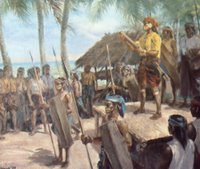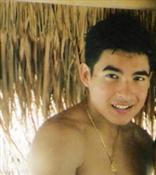The Pearl of the Orient in a Glance
 The Philippines, also known as the pearl of the orient, is an archipelago located in southeast Asia. It consists of about 7,000 islands; a little more if it's low tide. It's quite hot all year round, and it seems that the heat only dissipates sometimes during the monsoon season or "wet season." During this time a series of typhoons slam the Philippines with strong rains. Apart from typhoons causing occasional floods, the Philippines also experiences volcanic eruptions every now and then; Mt. Pinatubo, Mt. Mayon, and Mt. Taal are some of the more active Philippine volcanoes in the past century.
The Philippines, also known as the pearl of the orient, is an archipelago located in southeast Asia. It consists of about 7,000 islands; a little more if it's low tide. It's quite hot all year round, and it seems that the heat only dissipates sometimes during the monsoon season or "wet season." During this time a series of typhoons slam the Philippines with strong rains. Apart from typhoons causing occasional floods, the Philippines also experiences volcanic eruptions every now and then; Mt. Pinatubo, Mt. Mayon, and Mt. Taal are some of the more active Philippine volcanoes in the past century.Filipinos are some of the friendliest and most fun-loving bunch of people you'll ever meet. However, some of these same people will not think twice to fool, steal, or take advantage of you in some way if they think they can profit from it. Unfortunately, the Philippines is still a third world country for the most part and so the majority of the people are very poor and struggle in their daily lives. The country also has its fair share of litter and pollution. Top of the line sky scrapers can be found in metropolitan areas such as Manila and Cebu, and straw huts are still being used in provincial areas.
Food is exceptionally delicious in the Philippines, but most of these are high in fat as is usually the case for great tasting food. Most things in the Philippines are cheaper in price than what you will find in more developed countries. But Filipino wages are also very cheap.
If you plan on visiting in the Philippines you will probably land via the Ninoy Aquino International Airport in Manila, although an airport can also be found at Clark Air Base and Cebu City. You will probably want to arrange for ground transportation beforehand for taking you to your desired location within the Philippines. Otherwise, you may find yourself getting ripped off by the taxi drivers. One of the first things you will notice when you step out of the airport is the intense heat, the crowds of people and traffic, the manner in which the people drive, the litter and pollution, and the humongous billboards. You will also notice how everyone calls you sir, ma'am, or boss and acts overly polite. Some are being friendly but don't be fooled, most of the time it's just a facade to hide their less presentable intentions. You will be approached by old beggars, young hustlers, and tugging children, so prepare yourself. Although you may feel sympathetic, I wouldn't recommend giving them anything as they usually don't spend it as they should.
You will see sari-sari stores everywhere, which are usually small versions of stores you would find in a typical gas station that sells general items. I mentioned the traffic, and I must say that I wouldn't want to maneuver through the mess of traffic they create in Manila and other urban areas. Even driving (or walking) down rural roads can be dangerous as most drivers make a habit out of fearless passing. Stray dogs, cats, and other animals can be found roaming the streets. I wouldn't mess with them to avoid getting bitten, infected, or hassled by their owner.
Produce is usually fine to buy in the Philippines (always wash though). Fish is fresh if you go to the open markets early in morning. As far as meat and poultry goes, sanitation isn't that great so I would just recommend cooking until well done to avoid getting sick. Water doesn't taste that great either and you may experience a bad case of traveler's diarrhea after a few days from arrival. You can boil it, buy bottled water (although it's not guaranteed that the bottled is any different from tap), or just let your intestinal flora adapt to the tap water (especially if you're staying in the country for a while). "Chicheria" (chips, crackers, etc.) and other processed foods is abundant. Milk, cheese, and other dairy products will be hard to find.
Fast food is readily available as McDonald's, Jollibee (like McDonald's), Greenwich (like Pizza Hut), and Chow King (Chinese fast food) have infested the place. Food is dirt cheap for the typical foreigner or tourist, even in the local restaurants. You may have a hard time finding a five star hotel or something that even comes close if you're staying outside of Manila. Although Filipinos learn quickly and work hard when they need to, a lot of Filipinos are not very professional and can sometimes develop a nasty habit of being lazy. There are lots of beaches in the Philippines, and a lot of the beaches are dirty (in some cases, very dirty). Don't be surprised to find cans, plastics, diapers, feces, and other types of trash and debris in the water of a non-resort locale (and sometimes even at the resorts).
Boracay, Puerto Galera, Puerto Princesa, and Cebu have more tourist-oriented beaches and facilities. If you're more of a party-goer, Boracay and Cebu would be the perfect place. If you're more in need of some peace, the Puertos would be more your thing. Or why not experience all four yourself and find out? Other tourist hot spots include but are not limited to Baguio (cool weather, rice terraces), Manila (urban frolicking), Zambales (Subic Base and Hundred Islands), Bohol (Chocolate Hills, near Cebu City), and Palawan (spelunking, trekking). Bars are quite common in the Philippines if you're into bar-hopping, drinking, and go-go dancer amusements. I would always travel with a buddy or two or three, especially if you're roaming at night or travelling through Muslim infested regions. Mindanao is the Muslim hotspot. You should also watch out for the NPA (New People's Army) as they oppose foreign intervention. NPA members and affiliates are all over the Philippines, but especially in the rural areas. So those are who you watch out for... the Muslims, the NPA, and the other NPA (people with no permanent address, hehe).
You should also watch out for who you date in the Philippines. STDs are not uncommon, and hookers aren't either. And sometimes hookers aren't the gender you expected them to be either. Homosexuals are all over the place there, so don't be surprised if you meet several and meet some that you thought were women. But as far as the real Filipina women goes, don't be surprised if you fall head over heels for one of them (this is considering you didn't already fall in love with one of the many attractive Chinese flight attendants of China Airlines). Just as anywhere else in the world, Filipinas can be downright gorgeous, downright butt ugly, or just the plain medium blah. But it's more than skin deep, right? Right. You will also have to take into account that many of the Filipinas hide, lie, manipulate, and have an overwhelming lust for wealth. Oh yes, and don't be surprised if their loyalty to you is overruled by their loyalty to their family (who, by the way, view you as the golden rooster who can allow their hen to lay their share of golden eggs that they've been yearning for all their lives) .
But Filipinas also have a desirable side. They hold traditional values and some actually really do love you (and will continue to exhibit their love for you endlessly). But those are hard to find nowadays anywhere in the world. And please note that the aforementioned Filipina descriptions are purely stereotypical; just as anywhere else in the world, women come in all shapes, sizes, and personalities in the Philippines. You just have to find one that suits your liking.
As far as communication goes, English is widely spoken. You may want to invest in a cell phone as the Philippines is the txt capital of the world (even the dirt poor have cell phones).
Nursing and IT seems to be the boomers for jobs in the Philippines. Registered nurses are sometimes lucky enough to go abroad, and the IT sector is seeing growth as the US is beginning to realize the profit of outsourcing most IT jobs to lower waged Asian IT professionals. But for the most part, jobs are scant in the Philippines (especially for foreigners) and are usually not desirable (either because of the pay or the nature of the job itself). Political corruption is rampant, and only the very rich get richer. The rest are left to fend for themselves, hence starvation, poor health, the homeless, and theft are also rampant.
Holidays and festivals are wonderful in the Philippines. Filipinos do know how to put on a party. Fiestas are vibrant and the food is always plenty. The Christmas holidays are usually the best celebrations of the year. "Chismis" or gossip is very common. What did you expect? Remember that most of the Filipinos are either homeless, jobless, lazy, or are just plain talkative. So don't go to bed with multiple women who live in the same neighborhood, because you may end up with one too many protective fathers chasing you with a machete. Tricycles and jeepneys (old WWII jeeps revamped) are the typical local means of transportation. Always demand your change, you can't support the whole union.
As far as sports goes, basketball, billiards, and boxing are the most popular (and probably in that order).
Showbusiness stars are a hit in the Philippines. Actors, singers, sports stars, sitcom hosts, and matinee idols are loved by the Filipinos, who are fanatic about showbusiness and mainstream entertainment. Filipino movies are not that great compared to international standards. But Filipinos can sing, and karaoke is a popular past time there. Drugs and alcohol are common, and so are corrupt police officials. I'm sure that if it were plotted, statistics would show a direct relationship with average income and moral standard for the Filipinos. As you can see, the Philippines has more than enough flaws to make people to want to leave the country, but despite the detractors, something enchanting about the ambiance of the Pearl of the Orient keeps many coming back, myself included.
Author: David Eric Poarch http://coconuter.blogspot.com/



